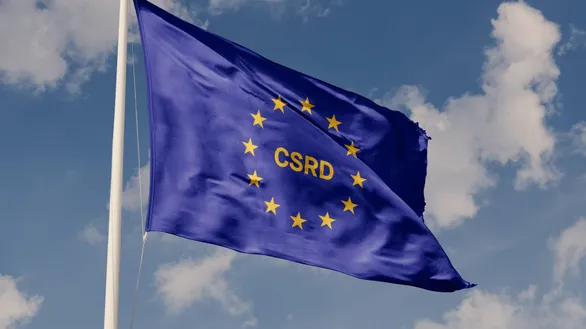The increasing importance of Environmental, Social, and Governance (ESG) issues has changed the way businesses operate, across industries and geographies.
Meanwhile the ESG landscape itself is ever-evolving and new trends are appearing which will shape businesses in 2024 and beyond.
So what are those key trends? How can technology help your business to get the best out of them? And how can you gauge whether your company is a leader or a laggard in sustainability transformation?
Thomas Husson, Vice-President and Principal Analyst at Forrester, and Andrew Winston, author of ‘Net Positive: How Courageous Companies Thrive by Giving More Than They Take’ recently joined Sweep’s CEO and co-founder Rachel Delacour for an in-depth discussion about these and other related topics.
Here are our top takeaways.
The Green Market revolution will be as big as the industrial revolution
Climate change is the number 1 emerging global risk, and five of the top ten emerging risks are environment-related, according to analysts. In response to these risks, the green market revolution is growing, and it will reshape life for most people on the planet in the same way that the industrial revolution of the 18th century onwards did.
Our collective response to climate change is expected to bring about many of the same evolutions as we have seen throughout the industrial era: increased innovation, an overhaul of the way we use transport, transformations of our farming, manufacturing and consumption models, mass migrations, and changes in our energy production and usage.
But where industrialisation heralded an increase in carbon emissions, resource exploitation and benefits only for participating countries – the opposite will be true of the green market revolution. Benefits can be shared globally, we will emit ever less carbon, and optimize our use of natural resources.
And while sustainability has long been seen as an ethical question, it’s now joined by business and physics in fuelling the green market.
“The green market revolution will change everything we do, from what we eat to how we move, and have great societal impact” – Thomas Husson, VP & Principal Analyst, Forrester
Regulation, regulation, regulation
Compliance is still seen as the key driver for adopting environmental sustainability reporting metrics, with 48% of sustainability and technology decision-makers and influencers picking it as the key driver for reporting on ESG metrics.
Top of mind is the CSRD, with many other existing and soon-to-be-introduced regulations focussing C-Suite minds on reporting.
Aside from ethical questions and reputational risks, there can be high costs for non-compliance, while on the flip side, adhering to ESG regulations will improve business transparency, credibility, and drive sustainable practices which are not only good for the environment, but also for the long-term success of the company, such as switching to renewable rather than finite energy sources. Even before the CSRD came into action, almost half of the 50 biggest companies in the European Union had already set Scope 3 emissions reduction targets, recognizing the need to track and act upon their data.
“New laws demanding transparency, tracking, data are going to drive [transformation] even faster throughout value chains… It’s time for businesses to set their sights higher” – Andrew Winston, author
Data is your friend, but choose the right technologies
In 2024, tracking, reporting and acting on your ESG metrics doesn’t have to be onerous.
Artificial intelligence innovations in the climate tech sector will transform climate action in 2024 and beyond, fuelling the green market revolution. At Sweep, AI will accelerate and streamline the process of calculating emissions for users of our platforms. Faster calculations means companies can get more precise data on their ESG footprint, and act quickly across their entire supply chain.
A word of caution: it is important to choose the right technologies. AI can jump-start and scale your climate data analysis, but it is essential to have the right team in place, which understands the technology in order to effectively use it.
As a result, Chief Technology Officers and Chief Sustainability Officers are set to collaborate much more closely in 2024. Co-ordination between CSOs and CTOs will help to get the best out of new technologies such as AI, and avoid complex tech infrastructures which themselves contribute to higher emissions.
“Data is at the heart of a sustainable transformation, and the network is key” – Rachel Delacour, Sweep
Don’t believe the ESG backlash
Major elections in the United States and United Kingdom will see climate cast as a bipartisan issue. But whatever the outcomes of these votes, public sector decisions will not hold back private sector climate progress.
The proportion of consumers who consider themselves environmentally-conscious is high: 85% in Europe, 75% in Australia, and 74% in the United States.
In 2024, the number of “green” consumers will stay constant, despite climate chaos and political backlash – and they know how to spot greenwashing.
Companies are increasingly buying into the evidence that building a sustainable business is essential for their own competitive edge and, ultimately, their longevity.
As businesses show via their strategic decision-making that they recognise this shift in consumer sentiment, the risk of reputational costs will drive corporates in the United States to continue to take action on their ESG credentials, regardless of the election results.
Meanwhile, Europe will continue to build on its already strong climate regulation frameworks, and the victorious party in the UK’s general election will likely revitalize the country’s climate plans, in order to not lag too far behind.
“Multinationals can’t just talk about shareholders any more. It isn’t really fitting the time, or what especially younger people expect” – Andrew Winston, author
Measure your maturity, and take action
European firms lead the pack when it comes to maturity on ESG strategy: 88% of the EMEA’s 50 biggest companies have named a sustainability lead, compared to 61% of Global 200 companies.
But even if you feel left behind, it’s not too late.
Start with data collection and make it meaningful: a continuous process which will allow you to track your progress, change your business actions in response, and model the future impacts of different strategies.
And remember the network effect: communicate with partner companies about your strategy, and explain the business opportunities of it to achieve maximum buy-in.
Don’t worry about making mistakes: the beauty of data collection is that data puts you in control and enables you to open your books.
“In financial reporting, we know it’s OK to make mistakes, as long as you have enough features to be able to control it. It’s the same for extra-financial reporting” – Rachel Delacour, Sweep CEO and Co-Founder
Want more insights on these topics? Watch the replay of our webinar here
How Sweep can help
Sweep empowers you to take the lead in your decarbonization strategy, ensuring a sustainable and transparent path towards your climate targets:
-
Facilitate efficient data collection and provide tools for collaborative reduction efforts across your value chain.
-
Model value chain emissions using benchmark data and identify emission hotspots.
-
Set collaborative reduction targets, aligning with industry standards.
-
Analyze emissions with market-standard metrics and flexible reports.
Get in touch to learn more.




